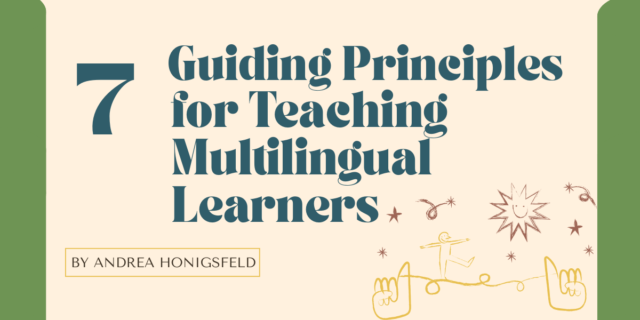
The name [Bridging level English learners] suggests that students are reaching an advanced level of proficiency that is often comparable to their monolingual peers. Most frameworks recognize that students at this level are at an advanced level of language development, metaphorically conjuring up the image of a bridge that connects these students to full competency with the language.
ELs who have reached the Bridging level of language proficiency continue to represent a range of language and literacy skills across the four domains. Language acquisition is still fluid, individual, and ever changing, so continue to expect your ELs to demonstrate different levels of skills in listening, speaking, reading, or writing.
We must recognize that language acquisition is a dynamic process that does not end when a child achieves the highest level of language proficiency. As before, we cannot allow a label to define a child and must look at each student as an individual learner. A shared unique characteristic of Bridging level students is their demonstrated success of acquiring advanced skills across all four domains: they can read and comprehend complex texts; they can express themselves orally and in writing across topics, both familiar and unfamiliar to them; and they maintain both personal and academic dialogues with increasing confidence. They can also take on leadership roles and support ELs at lower levels of proficiency as their role models and bilingual peer bridges.
When it comes to listening, you can expect evidence of high levels of English comprehension. Bridging level students are likely to be able to:
- understand main ideas, supporting details, speaker’s purpose, and other more nuanced aspects of oral language
- understand and respond to both everyday and academic conversations of increasing length and complexity
- understand multistep directions
- communicate fluently and spontaneously with minimal hesitation, self-correction, or rephrasing
When it comes to reading, your Bridging level students will demonstrate more complex skills as they begin to:
- read and understand texts on familiar as well as novel topics with appropriate speed and fluency
- read for enjoyment and academic purposes with fluency
- figure out meanings of new words and complex sentences using context clues and prior knowledge or other linguistic resources
- make sense of complex texts using various comprehension strategies, occasionally requiring scaffolds and supports
With writing, Bridging level students will be able to:
- effectively communicate ideas related to familiar and academic topics
- write for personal and academic purposes with increasing fluency and length
- take notes based on information they read or listen to with increasing accuracy and detail
- produce written texts of various length and purpose with minimal errors that do not impede the overall meaning.
In general, students at the Bridging level demonstrate increased independence and fluency in all four language skills as well as with academic literacy skills. This growth supports their language and literacy development across a variety of grade- and age-appropriate academic settings.
…
This blog has been adapted from Growing Language and Literacy. You can learn more at Heinemann.com
 Follow us on Instagram @heinemannpub to stay up to date on the latest books, your favorite authors, and upcoming events!
Follow us on Instagram @heinemannpub to stay up to date on the latest books, your favorite authors, and upcoming events!
 Dr. Andrea Honigsfeld is Associate Dean and Director of the Doctoral Program (Educational Leadership for Diverse Learning Communities) at Molloy College, Rockville Centre, NY. Before entering the field of teacher education, she was an English as a Foreign Language teacher in Hungary (grades 5-8 and adult), an English as a Second Language teacher in New York City (grades K-3 and adult), and taught Hungarian at New York University. A Fulbright Scholar and sought after national presenter, Andrea is the coauthor or coeditor of 20 books on education and numerous chapters and research articles related to the needs of diverse learners. Andrea is coauthor of the Core Instructional Routines books with Judy Dodge. Visit Andrea at www.andreahonigsfeld.com
Dr. Andrea Honigsfeld is Associate Dean and Director of the Doctoral Program (Educational Leadership for Diverse Learning Communities) at Molloy College, Rockville Centre, NY. Before entering the field of teacher education, she was an English as a Foreign Language teacher in Hungary (grades 5-8 and adult), an English as a Second Language teacher in New York City (grades K-3 and adult), and taught Hungarian at New York University. A Fulbright Scholar and sought after national presenter, Andrea is the coauthor or coeditor of 20 books on education and numerous chapters and research articles related to the needs of diverse learners. Andrea is coauthor of the Core Instructional Routines books with Judy Dodge. Visit Andrea at www.andreahonigsfeld.com


